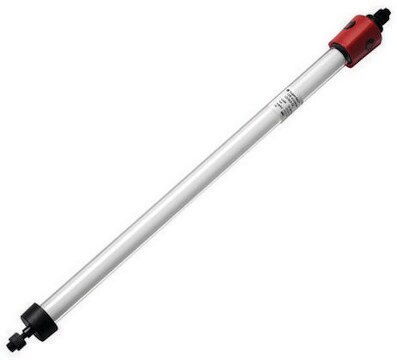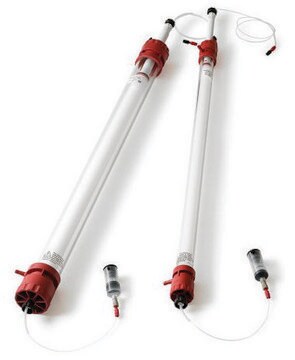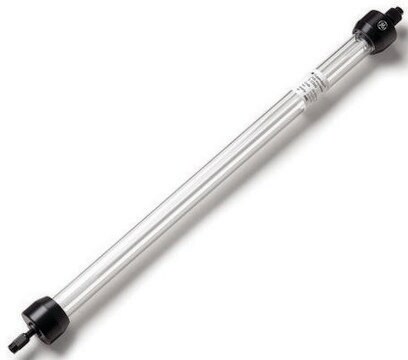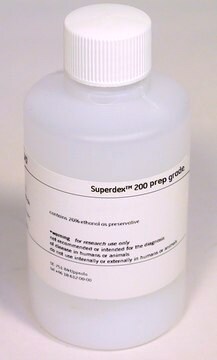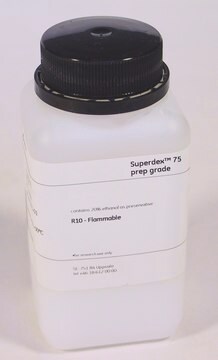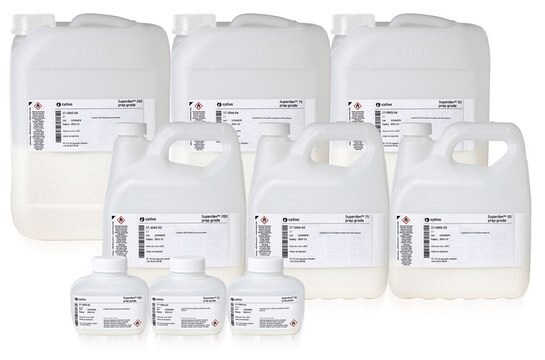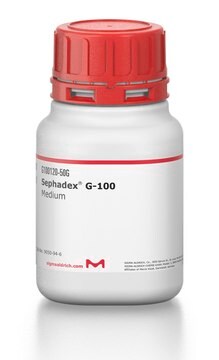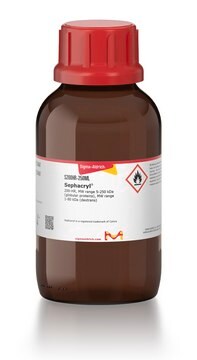S6782
Superdex®
Superdex®200 Prep Grade
Synonym(s):
Size exclusion media, Superdex column
Sign Into View Organizational & Contract Pricing
All Photos(1)
About This Item
Recommended Products
Quality Level
form
suspension (20% aqueous ethanol)
technique(s)
protein array: suitable
matrix
cross-linked agarose
particle size
24-44 μm
pore size
1-100 kDa MW range (dextrans)
10-600 kDa MW range (proteins)
operating pH range
1-14(short term)
3-12(long term)
storage temp.
2-8°C
Looking for similar products? Visit Product Comparison Guide
General description
Combines the high selectivity of a Sephadex matrix with the chemical and physical stability of crosslinked agarose.
Application
Superdex® is used for protein chromatography, gel filtration chromatography, gel filtration media, resins and separation media. Superdex® has been used for the purification and characterization of a novel laccase from the edible mushroom Hericium coralloides. Superdex® has also been used for the purification and mechanism exploration of a potential human hepatocellular carcinoma inhibitor from Bauhinia purpurea L. seeds.
Optimized for high resolution preparative separations by size exclusion chromatography. Recommended fractionation ranges are listed for globular proteins and dextrans.
Legal Information
Superdex is a registered trademark of Cytiva
Signal Word
Warning
Hazard Statements
Precautionary Statements
Hazard Classifications
Flam. Liq. 3
Storage Class Code
3 - Flammable liquids
WGK
WGK 3
Flash Point(F)
104.0 °F
Flash Point(C)
40 °C
Choose from one of the most recent versions:
Already Own This Product?
Find documentation for the products that you have recently purchased in the Document Library.
Customers Also Viewed
G Iberer et al.
Journal of chromatography. A, 921(1), 15-24 (2001-07-20)
In size-exclusion chromatography (SEC), proteins and peptides are separated according to their molecular size in solution. SEC is especially useful as an effective fractionation step to separate a vast amount of impurities from the components of interest and/or as final
J Oh et al.
Human molecular genetics, 9(3), 375-385 (2000-02-03)
Hermansky-Pudlak syndrome (HPS) is a rare autosomal recessive disorder in which oculocutaneous albinism, bleeding tendency and a ceroid-lipofuscin lysosomal storage disease result from defects of multiple cytoplasmic organelles: melanosomes, platelet dense granules and lysosomes. The HPS polypeptide, a 700 amino
Marcel Zamocky et al.
The Biochemical journal, 418(2), 443-451 (2008-11-13)
Phytopathogenic fungi such as the rice blast fungus Magnaporthe grisea are unique in having two catalase/peroxidase (KatG) paralogues located either intracellularly (KatG1) or extracellularly (KatG2). The coding genes have recently been shown to derive from a lateral gene transfer from
T Sato et al.
Journal of the American Society of Nephrology : JASN, 10(6), 1242-1252 (1999-06-11)
Mesangial cell (MC) injury is a characteristic feature in the early phase of Thy.1 nephritis. The present study investigates the contribution of complement to MC apoptosis in this experimental model of kidney disease in rats. Thy.1 nephritis was induced by
Anna Lundquist et al.
Biomedical chromatography : BMC, 20(1), 83-87 (2005-06-15)
We studied the effect of charged lipids or detergent on the retention of drugs and an oligonucleotide by immobilized liposome chromatography to characterize solute-membrane interactions. This is a novel approach in analysis of oligonucleotide-liposome interactions. The charged lipids (phosphatidylserine or
Our team of scientists has experience in all areas of research including Life Science, Material Science, Chemical Synthesis, Chromatography, Analytical and many others.
Contact Technical Service